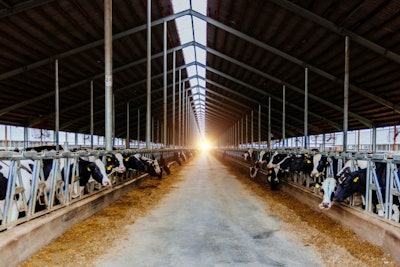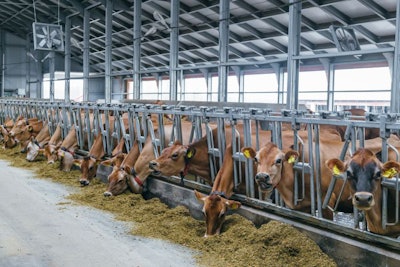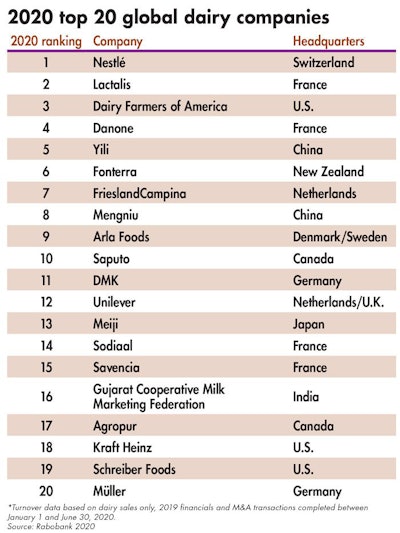
Focus on sustainability, ingredient costs serve as driving force for dairy rations
Global dairy producers continue to face milk price and feed cost volatility in 2021, as markets and economies begin to stabilize after the demand and supply chain shocks of the COVID-19 pandemic last year.
Rabobank forecasts a 1.1% increase in 2021 milk production across the Big 7 dairy-producing regions: the U.S., the EU, New Zealand, Australia, Brazil, Argentina and Uruguay.
The global dairy market has reached US$413.8 billion in the first half of 2021 and is expected to continue to grow through the remainder of the year, MarketWatch reports.
To capture a glimpse of the current state of the global dairy sector, Feed Strategy collected the opinions of dairy and feed industry stakeholders, asking them to reflect on the factors influencing milk production and dairy feed volumes. The Dairy Outlook report aims to identify the top trends shaping dairy production in 2021 and beyond.
Top 7 global dairy trends
1. Sustainability and dairy production’s impact on climate change
Recently, the Intergovernmental Panel on Climate Change’s (IPCC) 2021 report presented a stark warning: “Climate change is widespread, rapid and intensifying.”
All sectors of animal agriculture have been under pressure to reduce their environmental footprint; however, the dairy industry will no doubt see a heightened level of scrutiny in the years ahead.
According to the United Nation’s Food & Agriculture Organization (FAO), global livestock production contributes 14.5% to the total man-made greenhouse gas (GHG) emissions, with dairy production accounting for nearly 30% of this figure.
To reduce their environmental impact, many proactive food companies and dairy producers are instituting voluntary sustainability programs. For example, Nestlé, the world’s largest dairy, food and beverage company, aims to achieve net-zero carbon emissions by 2050.
Sustainability “is no longer nice for a business to have, it is a must have. It is a license to operate,” says Robert Erhard, Nestlé’s corporate sustainable agriculture development/head of dairy.
Given the urgency of the climate crisis — not only in the eyes of scientists, but for many consumers — it is fair to assume that top-down sustainability requirements will be imposed on many dairy producers and their supply chain partners.
“We will continue to see commitments by the industry to reduce environmental impact and greenhouse gas emissions,” says Ben Laine, dairy analyst, Rabobank. “Dairy producers will have to continue considering these commitments, including how to measure their operation’s impact, in their management decisions.”
Laine believes these efforts will lead to the increased adoption of new technologies, such as methane digesters and feed additives aimed at reducing enteric methane emissions in dairy cattle.
“It will also mean more developments in markets for carbon sequestration in crops and the need for managing the complicated maze of carbon credits and ownership along the dairy supply chain — from the feed inputs through the milk market,” Laine concludes.
Peter Williams, Feedworks USA Ltd. partner and manager for Agolin in North America, suggests the dairy industry make it a point to communicate how dairy cattle make use of byproducts and co-products humans and other monogastric cannot consume and upcycle this waste into nutrient-dense foods.
“Dairy farmers can play a significant, positive role in climate change mitigation,” Williams says. “All of this positions dairy as an important product for human health that also can be produced in an environmentally friendly manner.”
2. Consumer demand, adoption of plant-based dairy alternatives
After COVID vaccines became available, consumer behavior began inching back to normal with dining, tourism, events and entertainment destinations coming back online in full capacity — depending on the COVID threat levels and restrictions of the respective regions.
The foodservice sector is recovering but is not expected to reach its 2019 pre-pandemic levels in 2021.
“The demand for dairy products through foodservice will continue to grow,” says Ben Towns, director, global business, Arm & Hammer Animal and Food Production. “This should have a positive impact on dairy prices throughout the supply chain.”
Several other sources caution COVID-19 variants, such as Delta, may bring its tenuous rebound to a halt.
Meanwhile, plant-based dairy alternatives continue to gain popularity.
According to the Good Food Institute, plant-based milk already accounted for 15% of all retail milk sales in 2020. As the technology behind and taste of dairy alternatives advances, traditional milk and dairy products may lose more market share, but all the effects won’t only be felt at the grocery register.
“I think the greater trend, which should be more concerning, is the use of fermentation to produce yeast to produce milk compounds or milk-like compounds,” says Aidan Connolly, Cainthus CEO and president of AgriTech Capital. “This could end up removing or reducing the usage of some very valuable milk components, which have been generating huge profits for some of the milk companies. Because if they lose that revenue stream, if these different forms of yeast can produce that instead of taking from milk, that possibly could have a bigger, more substantial impact on dairy productivity than worrying about some of the ‘nut juices’ that are that are coming to the market.”
3. Milk price volatility
During the COVID crisis, “milk prices fluctuated wildly as supply chain issues made many dairy farmers wonder if they would have a consistent market for their milk,” Towns says.
Milk prices remain volatile, but have stabilized.
“The milk price outlook for the next few months is below breakeven for most dairies,” reports Randall Greenfield, vice president, sales and business development, Vita Plus Corp. “For six to 12 months beyond that, prices are nearer to breakeven, but don’t show great opportunity for profit. Some of these months’ futures contracts did spend time in a profitable range, so hedging strategies will be key in determining whether a dairy survives or profits over the next six to eight months.”

Retailers and food companies may require sustainability programs and additional measures to reduce methane and carbon emissions from their supply chain partners, including feed manufacturers. (Mulderphoto | Adobestock.com)
4. Export markets crucial
Global trade, both for dairy products and grains, have contributed to volatility in dairy farm margins, Laine notes.
“Dairy producers will need to aggressively manage risk on both the feed cost and milk price sides of their margins,” he says.
Exports will drive dairy producer profits in the near term. Greenfield suggest that at least 20% of U.S. dairy production must be exported “for prices to break even or improve.”
China’s recent significant dairy product imports have been good for the global dairy sector and prices.
In the first half of 2021, U.S. dairy exports to China grew by 17%, the U.S. Department of Agriculture (USDA) Foreign Agricultural Service (FAS) reports. China, the world’s third largest milk producer, is growing its domestic production, but has only been able to meet 70% of demand.
“We’ll need that level of interest and support to soak up the continuous and ongoing growth in the supply of milk we’re producing here in the U.S.,” Towns says.
Greenfield agrees: “I believe exports, in general, will rule dairy markets going forward. While domestic consumption still clears most of the dairy produced in the U.S., exports clear the “marginal” production that generates the market price signals. As with grain, I believe China will be the biggest single driver in our global dairy market. The sheer number of Chinese people who could regularly eat more dairy foods may become our dairy market ‘maker’ for the next few decades.”
5. Consolidation leads to larger herds, dairies
Continued consolidation and growing farm sizes “seem to be accelerating, not decelerating, with 5,000-cow dairies as the norm, not the exception,” Connolly says.
In the U.S., Laine notes farm-level consolidation is moving toward larger herds, a trend highlighted by the national dairy herd’s shift toward the center of the country, where producers are “seeking the benefits of economies of scale in areas where scale is achievable.”
“The nutrition business, the feed business, will have to make some big pivots in the next few years,” Connolly adds. “The customer base is shifting tremendously. [Dairy production] is probably going to end up looking more like the chicken business or the hog business by the time it’s all over, with a relatively small number of family groups, even business groups, controlling large numbers of cows.”
6. Feed costs tighten margins
Ingredient availability, quality and costs are poised to remain a challenge throughout 2021 and into 2022 due to drought and extreme weather threatening global harvests and grain stocks.
High corn and soybean costs “affect almost all ingredients in a dairy diet, as forage prices must compete with the opportunity cost of growing grains,” Greenfields says. “Combined with the challenging dairy markets, high feed costs will put a strain on dairy budgets and cash positions/needs. As with dairy prices, good hedging strategies on the feed side can also tip the scales from loss to profit during periods of tight margins.”
Josh Hushon, North American dairy strategic marketing lead, Cargill Animal Nutrition, believes income over feed cost (IOFC) pressure from commodity and hay price increases will challenge profitability.
“Dairy ration costs are pointing up towards levels not seen since 2013, and forage digestibility issues or total inventories from a below-average harvest season may increase the price and need for complete feeds,” he says. “Efficiency will be key. Simply put, component efficiency is pounds of milkfat and protein divided by the pounds of dry matter intake. Any dairies below 12% on this critical metric should evaluate carefully.”
Milk prices have been stable but have not kept pace, which has made for tighter margins for dairy producers who purchase feed, Towns notes.
“The production cost of a liter of milk for dairy producers has increased significantly due to the shortage of raw materials and logistical challenges,” says Bertrand Bourmaud, global ruminant business development director, ADM Animal Nutrition.
As producers seek more cost-effective solutions, rations are reformulated to remove feed additives and/or replace ingredients for lower-cost alternatives.
“While this adjustment might have a short-term positive impact, there could be long-term production and health effects that have a negative impact on production and profitability,” Towns says.
7. Labor shortages lead to investment in automation
“Labor shortages continue to plague many dairy operations as producers find it hard to secure a consistent and reliable workforce,” Towns reports.
Connolly points to increasing investments in automated and robotic systems to fill the labor gaps.
Greenfield agrees: “The new technology offerings available to dairy producers seem to expand daily. Automated milking systems, new feeding software options, behavior/activity monitoring, camera/GPS technology for monitoring animals and employees, sensors that can detect milk components and more in the parlor are all options that our dairy customers are considering and/or implementing. The way farms are managed changes as more of these technologies are adopted.”
















